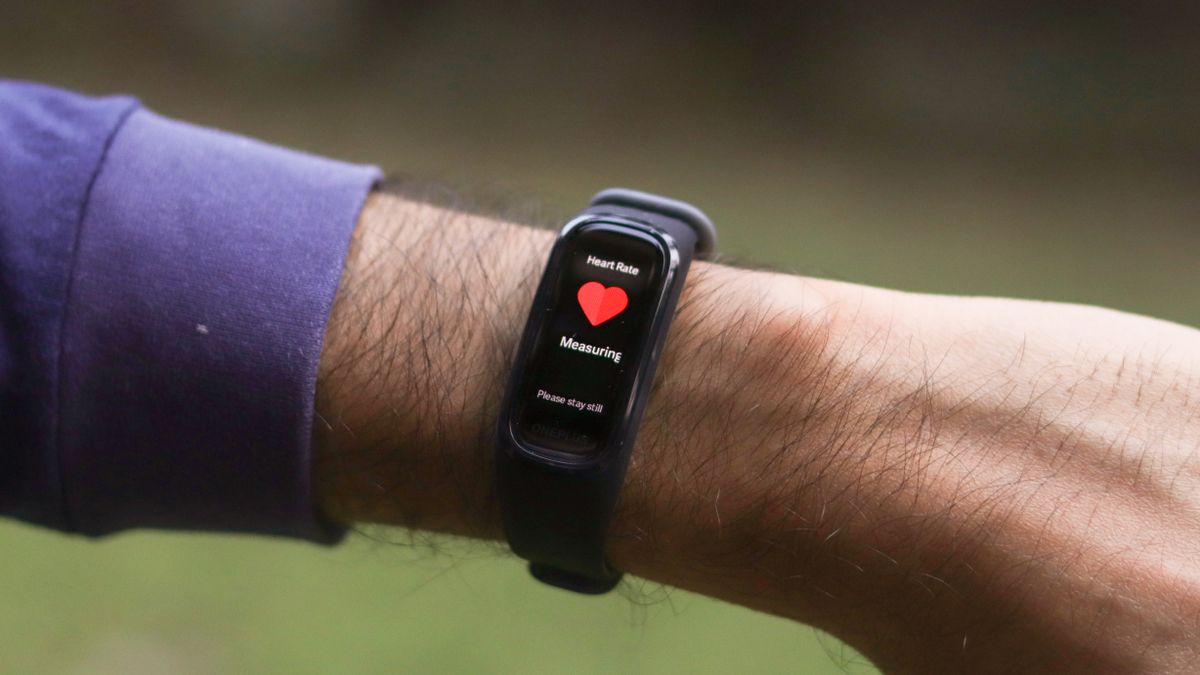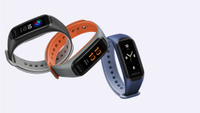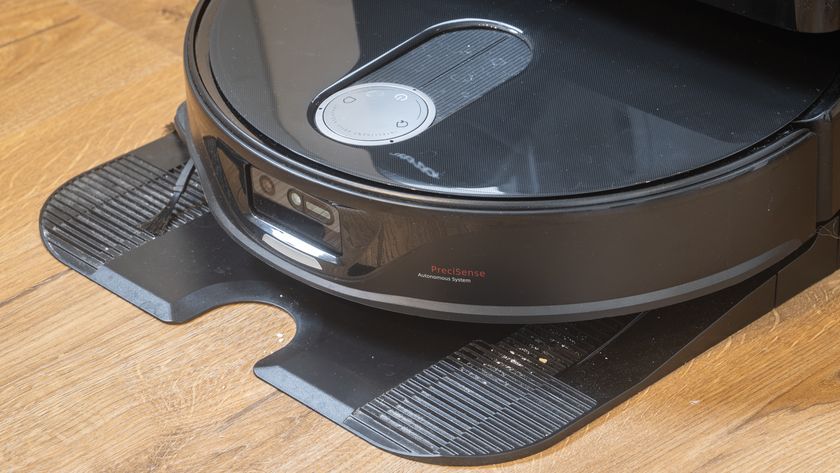TechRadar Verdict
The OnePlus Band comes pretty close to being a great fitness tracker in its first attempt, but it suffers from rookie mistakes that will take more time and feedback to be addressed in future generations.
Pros
- +
Sharp, responsive display
- +
Beautiful watch faces
- +
SpO2 monitoring, water-resistant
Cons
- -
Finicky charging cradle
- -
Average battery life
- -
Our screen is already scratched
Why you can trust TechRadar
Two-minute review
OnePlus' surprise start-of-the-year announcement of entering the budget fitness tracker space isn't much of a surprise if you've followed how smartphone companies have been expanding recently — trying to become an AIoT platform with other connected devices as a part of a bigger ecosystem.
In 2020 we saw OnePlus enter a number of new segments including affordable smart TVs, mid-range smartphones with the OnePlus Nord, N10 and N100 and true wireless earphones with the OnePlus Buds and Buds Z.
The next piece of the puzzle for the brand is wearables, which the OnePlus Band kicks off, and the upcoming OnePlus smartwatch will carry forward.
However, this next phase of expansion might be its toughest yet, as it takes on the competition from Xiaomi, Realme and Amazfit, without any of the first-hand experience or expertise.
The OnePlus Band comes pretty close to being a great fitness tracker in its first attempt, but does suffer from rookie mistakes that will take more time and feedback to be addressed.
Here's what it gets right: the display is pretty sharp and clear along with great colors. The AMOLED construction allows it to have perfect blacks while also saving some battery.
The interface is pretty fluid and responsive, but can take some getting used to, especially if you're already accustomed to the operating system of any other wearable. The minor design elements are also enough to make it stand out from the sea of generic minimalist fitness bands.
The OnePlus Band also offers a healthy selection of exercise tracking modes, along with the usual slew of sleep tracking, heart rate monitoring as well as blood saturation levels. As it also features an IP68 rating, you can even take it for a swim.
That being said, it scores low on some of the fundamentals such as recording and presenting the data in a detailed manner. Even the battery life is just average. Worst of all, the display doesn't appear to be that scratch-resistant, with our unit managing to pick up day-to-day damage.
As a basic fitness tracker, the OnePlus Band is certainly serviceable, but it doesn't go above and beyond. It fails to get a strong recommendation from us just because of how good the competition is. If competitors such as the Xiaomi Mi Smart Band 5 are not an option for you, then the choice is a lot simpler.
OnePlus Band release date and price
The OnePlus Band made its global debut in India on January 11, 2021. The OnePlus Band price is Rs 2,499 (around $34 / £25 / AU$45) for the package that includes the black band and a charger.
Replacement straps such as the Navy or Tangerine Grey band will set you back by Rs 399 (around $5 / £4 / AU$7).
There is no confirmation on availability in other markets such as the US, UK or Australia, so we will have to wait for more information from OnePlus on that.
At that price, it competes with the Xiaomi Mi Band 5, Realme Band, Honor Band 5, Samsung Galaxy Fit 2 and more, which have seen significant growth over the last year.
Design and display
- Weighs in at 22.6g
- IP68 and 5ATM water-resistant
- 1.1-inch AMOLED touchscreen



As with most fitness trackers, the OnePlus Band follows a simple design that consists of a capsule-shaped module enclosed within a silicone band. This minimalism leaves little room for differentiation once the display is taken out of the equation.
Hardware-wise, it seems to be a rebranded Oppo Band which launched in June 2020. But since it never made it out of China, that doesn't really matter.
The front has a 1.2-inch AMOLED display (21:9 aspect ratio) with subtle OnePlus branding below it. The logo is not as visible as the photos will suggest. The body of the tracker is rectangular with rounded edges, making it vertically shorter than most others. On the back are the heart-rate sensor, the SpO2 monitoring array and the pogo pins for charging.
Our unit already has a small ding on it which isn't going away. This scratch happened when it was dropped from about four feet onto grass, which isn't really a surface to be worried about. The scratch-resistance is unsatisfactory, so be prepared to be extra careful with your OnePlus Band.
We found the band to be a little too stiff to put on, especially for users with slimmer wrists.
It's confined in a silicone band that is pretty easy to detach for washing or charging. The outer part of the strap has ridges running from the top to the bottom, giving it a slight premium feel as well as some character. At the end is a strong snap button. All the first-party bands have a dual-tone finish, with our variant being grey on the inside.
We had no trouble using it outdoors either, thanks to a high brightness level. Scrolling through content is also very responsive, which is not something we see often on budget watches.
If you prefer your new wearable to look a little different than everyone else's Mi Band (whose design hasn't really changed since a few generations), the OnePlus Band will be right up your alley.
It doesn't look like a toy and is easy to match with most outfits. The entire package is also IP68-rated for water and dust resistance, making it suitable for swimming.
Overall, we like the design of the OnePlus Band. It makes no major mistakes, balancing simplicity and sophistication. At just about 22 grams, it's light enough to not feel uncomfortable.
Interface
- Non-intuitive UI
- First-party watch faces are great


It's not just the hardware that OnePlus plays safe with, as the software is also pretty straightforward. There's no capacitive button on the body; meaning, you'll have to resort to using the touchscreen for all navigation and controls.
Since a fitness tracker is not supposed to be a smartphone replacement like a smartwatch, OEMs tend to keep things pretty barebones.
On the OnePlus Band, swiping left or right from the main screen will cycle through the different watch faces. We're not particularly fans of this approach as the watch face isn't something that will be changed that frequently, that it had to be mapped to the most common input method.
It's the same logic as to why most wearables keep it a level deeper to not accidentally change the watch face.
The included watch faces are amongst the best-designed ones we’ve seen.
Only up to five faces can be stored on the watch, and even those have to be chosen from the selection available in the app. A total of 37 faces are currently available across sport, art, vibrant, minimalist, classic and wallpaper themes.
While the selection is pretty slim, the overall designs are pretty and modern, along with variants in other colors. The ones under the classic category are confusing though, and we still haven't been able to figure out how to read the time on them. If these aren't enough, you can even add use your own image gallery for the background.
Further, swiping vertically will take you through different apps and functions. The selection and order of apps can also be customized in the app. These include current daily activity progress, workouts, heart rate, SpO2, sleep tracking, guided breathing, weather, tools and notifications — just the right essentials.
There will be a slight learning curve for most users.
A rightward swipe will take you back to the previous screen while a long press will take you home. Needless to say, the OnePlus Band doesn't follow the standard navigation gestures that we've become accustomed to from using Android phones and other wearable devices for years.
Lastly, tapping on the main screen at any time will show the current status of the watch, in terms of Bluetooth connectivity, DND profiles and battery level. These can not be interacted with; only viewed.
You can also choose which apps should send notifications from your phone to your band. These are well-optimized to show ample information, be it a WhatsApp message or an email. Emojis are not supported though.
It also supports the standard slew of features such as media playback controls and camera shutter remote.
Fitness
- 13 sports modes
- Heart-rate and SpO2 tracking
- No stress tracking or menstrual cycles



If health and fitness have become an important part of your lifestyle, then getting a tracker might just be the last little push you needed to be consistent.
The OnePlus Band has some 13 dedicated exercise modes; outdoor run, indoor run, fat burn run, outdoor walk, outdoor cycling, indoor cycling, elliptical, rowing machine, cricket, badminton, swimming, yoga and freestyle. While that is a big list at first glance, you'll notice that many of them are very similar or overlapping in nature.
The more complex routines are preceded by a small explanation and tips to get the most out of a workout. Once started, the band will show the current heart rate, duration as well as some other specific metrics for select workouts.
For instance, the Fat burn run will ask you to speed up to get your pulse in the best range to burn the highest calories, which is a nice touch for beginners. We'd have liked to see a few more options such as football, strength training and HIIT.
Apart from workouts, the OnePlus Band also monitors your other vitals continuously. Heart-rate tracking can be set to take readings constantly, every few seconds, all to way up to once in six minutes. We found the readings to be fairly accurate for resting as well as working periods.
The other big feature is SpO2 tracking, which is a rare appearance in this segment. It can take readings while you're asleep or when you manually initiate one, post which you'll have to remain still for about half a minute.
Our blood oxygen saturation was almost always in the safe range of over 95%, so we can't really talk about how useful it will be as an emergency indicator.
Then there's sleep tracking which was very accurate and granular. Every morning you'll be greeted with information on how long you slept along with a breakdown between light and deep sleep. The app can show the segmentation in much more detail, along with specific tips on how to improve the sleep quality score.
We also liked the approach taken for the breathing exercises, where you'll be guided on how to regulate your breathing over a period of time. Along with visual cues on the screen, the band also offers strong vibration feedback which suggests when to alternate between inhaling and exhaling.
Overall, the OnePlus Band has ample tracking capabilities at an acceptable level of accuracy for beginners and enthusiasts alike. The app also allows you to add GPS tracking for runs or walks, as well as check your progress and daily activity such as steps, calories burnt, workout time and activity sessions.
If getting back to an active healthy lifestyle is on your cards, trying to complete these targets will prove to be a good starting point.
Companion app
- Uses the OnePlus Health app
- iOS support coming soon
- Easy to navigate
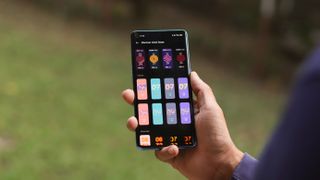
For any new connected device that is primarily meant to be a tracker, the companion app is an important part of the experience to assess the data and improve upon them.
The OnePlus Band can be connected with any Android device via the OnePlus Health app, with support for iOS coming in the near future. On Android, the initial pairing and setup was quick and easy.
It is divided into three main sections: health, fitness and manage. The health section will show all the key readings at a glance along with details on heart-rate, sleep, SpO2 and workouts.
The fitness tab will allow you to let the band harness the phone's GPS to track walks and runs. You can also set targets such as distance, duration and calories for each session.
The manage screen is for all the major tweaks such as choosing the watch face, setting preferences, checking for updates as well as a handy tool that will run you through how to use the OnePlus Band. We liked the inclusion of the option to sync phone notifications at the tap of a button, to quickly remove the older alerts and refresh the space.
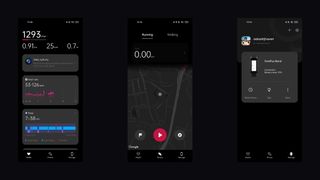
The OnePlus Health app is really well-thought-out, with all settings easy to find and toggle. This is a good thing for the most part, but this simplicity chase also means that some of the deeper options had to be axed for the sake of convenience.
Average users are unlikely to have any issues, but there are some glaring omissions such as stress tracking and menstrual cycle tracking. Since these don’t require any dedicated hardware, we hope that software updates can add these features.
While the apps of competitors can feel overwhelming, they are definitely better at giving us a better look at our fitness progress and other vitals.
Battery life
- 100mAh battery
- 7-10 days of battery life


OnePlus claims that the OnePlus Band can last for up to 14 days on a single charge.
In our testing, the best we could do was just over a week with moderate usage. Each day, we'd drop about 10-15% of the battery, with notifications turned on for most apps, and a 6-minute interval between pulse readings.
This is about average for a tracker in its class, but the Mi Band 5 easily beats it with over 10 days of battery.
For charging, you'll have to pop out the capsule and fit it in the included charging cradle securely. It's not bad, but having a magnetic connector that automatically aligns with the pins without having to separate the strap would have been a lot more convenient.
Still, it's not a big issue as it will have to be charged only about once a week or so.
OnePlus Band vs Xiaomi Mi Band 5 comparison


As you must have picked from our review, the Xiaomi Mi Smart Band 5 offers a better experience in many areas, even if it is just by a bit. Considering that the OnePlus Band has the same price, it becomes a tough recommendation, primarily because of the aforementioned omissions and the work-in-progress nature of some of the other features.
You should get the OnePlus Band if you don’t want to get Xiaomi’s budget fitness tracker, are fine with a lesser feature-packed app and prefer the bolder design. For most other practical purposes, the Mi Band 5 has a better app, along with more features, longer battery life as well as a large library of third-party watch faces and accessories.
Should you buy the OnePlus Band?



Buy it if...
The Mi Band 5 is not an option
Xiaomi's popular smart band is the easier recommendation for most users, but if you aren't a fan of it or it is not available in your country, then the OnePlus Band is a decent alternative.
You’re looking for a simple, affordable wearable
The OnePlus Band does fewer things but it does them well. If the mentioned omissions aren't a deal-breaker for you, and you prioritize simplicity over added features, it will serve you well.
You need to check notifications quickly
The OnePlus Band has been well-optimized to show more text on the screen and in a prompt fashion. Usually, we have to make do with about half a line of text but not here.


Don't buy it if...
You need reliable battery life
With the OnePlus Band lasting for only about a week with moderate use, it isn't the leader in this aspect. Even the charging experience is a bit finicky.
You’re serious about fitness tracking
Other fitness trackers use the same hardware and form factor to offer more features and better explanation of the recorded metrics.
You're not a careful user
Our OnePlus Band got scratched in one tiny drop after less than a week of usage. While we can't comment on long-term durability, we aren't too optimistic.
First reviewed: January 2021
Aakash is the engine that keeps TechRadar India running, using his experience and ideas to help consumers get to the right products via reviews, buying guides and explainers. Apart from phones, computers and cameras, he is obsessed with electric vehicles.
